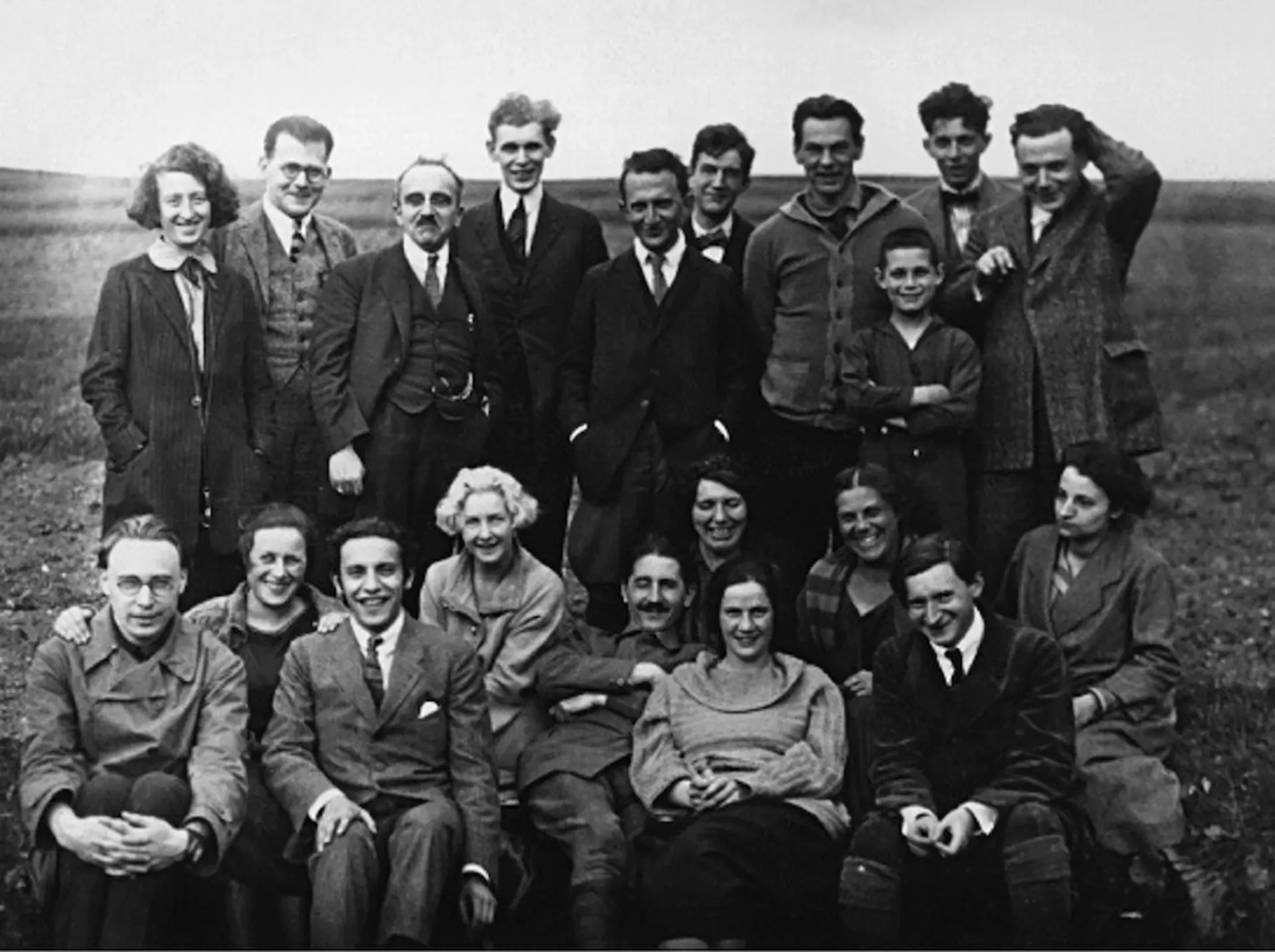I think Robinson’s formulation of racial capitalism can clarify our discussion of those multiple and intimate entanglements, but also demarcations and disanalogies, between slavery, colonialism, and the Holocaust that have become the object of such acute discursive struggles, as well as cynical polemics and excommunications. Robinson’s vantage point upends a tendency to treat antisemitism and Judeophobia as intra-European phenomena while anti-Black and colonial racisms would be seen to arise from encounters with a non-Western ‘Other.’ In the very first pages of Black Marxism, we read that racism “was not simply a convention for ordering the relations of European to non-European peoples but has its genesis in the ‘internal’ relations of European peoples.” As Robin Kelley underscores, the thesis of racial capitalism is grounded in the notion that “racialism had already permeated Western feudal society. The first European proletarians were racial subjects (Irish, Jews, Roma or Gypsies, etc.) and they were victims of dispossession (enclosure), colonialism, and slavery within Europe. Indeed, Robinson suggested that racialization within Europe was very much a colonial process involving invasion, settlement, expropriation, and racial hierarchy.”
Across the seventeenth and eighteenth centuries, with the consolidation of the capitalist world-system under British hegemony, what Robinson termed “the delusions of mediæval citizenship” came to be supplanted by the logics of race and Herrenvolk, which attest to the fact that “European civilization, containing racial, tribal, linguistic, and racial particularities, was constructed on antagonistic differences.” ‘Race’ as both metaphysic and mechanism shaping the practices of domination and exploitation was born in Europe. The Herrenvolk frame dominated as a mystification and legitimation of power on European soil in such myths as “Anglo-Saxonism” or the “Germanic race” while race “became largely the rationalization for the domination, exploitation, and/or extermination of non-‘Europeans’ (including Slavs and Jews).” This parenthetic comment is striking, both for its suggestion about the perceived non-Europeanness of Jews and for its allusion to the question of racial genocide, both of which are not further explored in Black Marxism.
In what follows, starting from the working hypothesis that the prism of racial capitalism can provide some profane illumination on the problem of the relationship between slavery, colonialism, and the Holocaust, I want to consider two distinct if interrelated questions. First, what might it mean to frame antisemitism as a modality of racial capitalism? Second, are we obligated to retain, as Robinson does in Black Marxism, the category of “civilization” to interpret and explain racial capitalism?
While the best-known products of the Frankfurt School’s research on antisemitism foreground the rhetorical, psychological, and metaphysical roots of Nazi Jew-hatred and anti-Jewish violence, the original research project on antisemitism published in 1941 by the exiled Institute for Social Research’s journal could be read as a contribution to a theory of racial capitalism avant la lettre. Its starting point is lucid and forthright: any effort to theorize antisemitism that treats it merely as an irrational and age-old cultural and psychological prejudice is doomed to irrelevance.
What is called for is a materialist framework for identifying the specificity of modern antisemitism that would be able to historicize its emergence from the crucible of capitalist social relations, thus accounting for the polemical association of Jews with the real abstractions of capital and law, and especially with money as a solvent of social order.
While racial capitalism may be encapsulated, following Ruth Wilson Gilmore, as the enshrining of the inequalities generated by capital—as a way to capitalize on race—the dominant form of antisemitism gleaned by Adorno and his colleagues is that of a racialization of capital. This allows the propagandizing of the social war on Jews as a struggle against abstraction. Instead of purely repudiating antisemitism as manipulation or prejudice, the Institute sought to detail how certain Jewish social character traits identified, magnified, and distorted by the antisemite “find their roots in the economic life of the Jew, in his particular function in society and in the consequences of his economic activity.”

The first is the notion that Jews do the “dirty” (if immaterial) work of capital, namely in their function as “middlemen.” As the Institute’s project notes: “From olden times the practice of extending credit has prevented the antagonism between the possessors of power and the economically oppressed population from leading to recurrent catastrophes.” But in the throes of crisis, the Jew becomes the perceived factor of impoverishment. The increasing importance of intermediary functions to modern capital is then the basis for the “maneuver of distraction” that presents an intrinsically Jewish “non-productive capital” as the source of social ills. Emblematic of this operation is the imaginary world of Richard Wagner’s music drama Der Ring des Nibelungen, which “contrasts the heroic productive Siegfried, a mixture of the munition manufacturer, the condottiere, and the rowdy, with the dwarf, a symbol of the owners, merchants, and the resentful, eternally complaining proletariat.” The Nazi struggle against Roman law—which the legal theorist Carl Schmitt played a prominent role in advancing—is then traced back to the political economy of Jewish life under capitalism, with its complement of ideological effects:
Since its Roman origin, civil law has been the law of creditors. Whereas it recognizes no difference between any groups or individuals but aims at the universal protection of property, it is a priori antagonistic to the debtor. Historically, because of the creditor role of the Jews, deriving from their functions as bankers and merchants, we find them usually on the side of Rational law. Their foes, on the other hand, favor a vague natural law based on the “sound instinct of the people.”
This affiliation with juridical abstraction, grounded in the historical trends determining the social positioning of certain Jews within the ambit of European racial capitalism, is then presented as the further basis for associating Jews with abstract intellectual labor tout court.
The ‘Research Project on Antisemitism’ was, among other things, an effort to explore how the antisemitic and fascist phobia for abstraction—and the related image of the Jew as the enemy of racial concreteness and authenticity—could be understood as the distorted refraction of real social processes marking the history of European racial capitalism. This effort was not without its pitfalls: in seeking to blast an emancipatory core out of the lethal stereotype of the Jew as the bearer of life-denying abstraction, it affirmed abstract thought’s “divest[ing of] human relationships and things of their taboos,” thereby seeming to abet a view of enlightenment rationality as the suppression or supersession of savagery.
Moreover, by seeking to base the very possibility of Nazi persecution in the political-economic shift out of a market economy, in the delinking of German capitalism from the anonymous, abstract, and impersonal compulsions of the market, it misrepresented Nazism as an authoritarian planned economy. This advanced a rather undialectical claim for the virtues of a market individualism whose termination was interpreted as the basis of the Jews’ “becoming superfluous.”

This theme of superfluity also emerges from a contemporaneous work, La conception matérialiste de la question juive (translated as The Jewish Question: A Marxist Interpretation), completed in 1942 by the Jewish Belgian Trotskyist militant and resistance fighter, Abraham Léon, murdered at the age of 26 in Auschwitz. In contrast to the Institute’s 1941 hypothesis, Léon developed some of Max Weber’s arguments about the Jews as a “people-class”—a group ascribed interstitial commercial and capitalist functions within a feudal world—to argue that it was the full transition to capitalism, rather than the rise of monopolies or authoritarian states, which had rendered the position of European Jews intensely precarious. While the Jews represented money-capital in a non-capitalist mode of production, with the intensification of the real subsumption of society by capital they retained their vestigial stigma as the people of abstraction, while losing any correlated social role. As Léon observed: “In relation to the people whose traditional bases of existence it destroys, capitalism blocks the road to the future after having shut the path to the past… The first to be eliminated by decadent feudalism, the Jews were also the first to be rejected by the convulsions of agonizing capitalism… The Jewish masses [in Eastern Europe] found themselves stuck between the anvil of decadent feudalism and the hammer of rotting capitalism.”
For Léon, as for Adorno (the principal author of the Institute’s research project), the study of contemporary antisemitism at the inception of its exterminatory turn meant giving primacy to the differential effects of racial capitalism over the continuum of anti-Jewish prejudice across European history. Tragically, neither Léon nor Adorno explored the way in which antisemitism could be understood relationally; how, following Claire Jean Kim, “racialization processes are mutually constitutive of one another” across “more than one scale at a time.” One way of addressing this relationality and “triangulating” anti-indigenous, anti-Black, and anti-Jewish racisms and their respective modalities of violence, is to think of the figure which is the sine qua non and foil of the discourse of civilization: the savage.
The savage is both emblematic of the epistemic violence of racial abstraction, and a device through which colonial racial capitalist practice constituted its domination, dispossession, and exploitation of differently racialized peoples. In an unpublished 1975 text on W.E.B. Du Bois’ Black Reconstruction, ‘Marxist Theory and the Black Savage,’ Robinson pointed to this centrality of savagery to the formation of racial capitalism:
…the stories of “advanced civilizations” require as a confirmation of themselves a negation: the Savage. “Civilizations” prove their historical significance by the destruction and/or domination of the Savage. Interestingly enough, the decline of “civilizations” is marked by myths of the reappearance of the Savage. American social ideology and historical consciousness had two such savages as their opposition: the Indian and the African. The destruction of the native Savage and the domination of the imported (alien) Savage were positive proofs of the superiority and historical mission of the new nation—the new American people.
These figures of savagery could, in turn, serve a disciplinary and ideological function in “the socialization of subsequent generations of less well-integrated classes and ethnic groups.” In Black Marxism and a brilliant later essay on the playwright Eugene O’Neill, Robinson would elaborate on the role of Irish “savagery” as a template for “the destruction of the native savage and the domination of the imported one.” This is a striking example of a process that Gilmore has starkly encapsulated as follows: “capitalism and racial practice codeveloped because the racial practice was already there and it had nothing to do with Black people.”
But what lines can be drawn between antisemitism and the colonial triangulation of indigenous, Irish, and Black “savagery”?

We easily forget that the very perception and understanding of First Nations in the Americas was shaped by a Biblical frame that employed the theological script of Jewish history to make sense of indigeneity. As the Italian historian of ideas Giuliano Gliozzi details, the “Judeo-genetic theory” of the origin of the indios played a critical role in the ideological—which is to say theological-juridical—battles between the Spanish Crown and the conquistadores over the forms of domination and exploitation to be applied in the newly-conquered territories. As Gliozzi writes, “what moved the men of the sixteenth and seventeenth centuries to formulate determinate hypotheses on the origin of the Americans was not an abstractly ‘ethnological’ interest but the need to justify and prefigure particular socio-economic relations in the colonial policy towards the New World.” Used by conquistadores to justify the hyper-exploitation, expulsion, and death of those who could be seen as having denied Christ, the “Jewish Indian” theory fell away due to a shift in the perquisites of colonial racial capitalism, namely as the colonists became more dependent on reproducible and taxable agrarian labor rather than sheer plunder and the abuse of native peoples as disposable enslaved workers in Spanish mines.
The same Biblical frames could then travel to other colonial settings as rationales for divergent policies. While the Biblical-juridical framing of “savagery” would give way to secular, Lockean-commercial rationales for dispossession, as well as polygenetic theories of race in the eighteenth century, the “Jewish Indian” theory proved quite resilient. The historian Craig Steven Wilder has traced its persistence in the first century and a half of the American university, and underscored its profoundly relational character. As he observes,
When European and European-American intellectuals explored Judaism and Jewish history for clues to the origins of native America they were also rummaging through the legacies of Christian antisemitism. One example: the axiom that God sent plagues and wars to punish native American communities for hedonism went largely unchallenged in the colonies and the assignment of Jewish ancestry to native Americans however speculative made this heavenly verdict even more credible: if Indians were Jews under this logic then they were not the innocent occupants of an unknown land but unrepentant sinners who had long… escaped God’s wrath.
Conversely, as justifications for dispossession came to take a more secular cast in the mid-eighteenth century, it meant terminating the proselytizing, pedagogical effort to “civilize” the natives. As Wilder notes, “there was little profit in struggling to uplift native Americans whom secular knowledge and religious knowledge now judged unsalvageable.”
[The] ascendance of… the biological racism that questioned the humanity of non-European people also redefined social relations among people of European descent. Early racial categorization traced human color and geography—Asians, Africans, Europeans and Americans—but it did not take long for Atlantic intellectuals to question whether such regional and complexional fissures were the only evidence of divine or natural favoritism: if dark skin was a timeless indicator of inferiority then there were likely also indicators of Jewish cultural spiritual and even biological inequality; in fact the very history of frustrated Christian missions and failed conversion crusades made Christian antisemitism receptive to racialization.
This is also why Wilder implores us “to think carefully and critically about the ways in which the histories of African Americans, Native Americans [and] colonial Jews actually get braided together in the eighteenth-century world and can never be understood without reference to each other.”
Studying a specific instance of Catholic anti-Jewish racism in a nineteenth-century example of “blood libel” in Damascus, the Italian mythologist and critic Furio Jesi would also note the persistence of the mutual constitution of anti-indigenous, anti-Black, and anti-Jewish racism, while underscoring the differential way in which a specifically Jewish “savagery” was projected by an antisemitism that straddled theological and civilisational logics.
Unlike the fascist racism of the 1930s, Jesi argues,
…nineteenth century antisemitic Catholic racism does not [include] the same accusation of “inferiority” [in] Blacks and Jews. It consists instead of the will to condemn the heinous deeds of a people which because of its intrinsic, “phrenological” (racial) nature, inexorably tends towards evil, to the ferocity of “savages” and which nevertheless (unlike Blacks) is not wholly “savage” but rather has hypocritically and externally civilized itself—and which has thus been able to continue to satisfy its blood-thirsty instincts within the very fabric of “civilized” societies. We are not dealing with a racism oriented towards the general perspective of all the human “races,” but with a racism that aims to distinguish, among apparently “civilized” men, and not among the others, those who hypocritically mask under semblances of civility their true “savage” nature, their “crude, ferocious and bloodthirsty spirit.”
For Jesi, in the end, an immanent critique of the “anthropological machine” that ceaselessly generates these fatal couplings of power and difference was not sufficient. It was necessary, as he put it, “to push beyond bourgeois culture, not merely to try to slightly deform its frontier barriers.” This means, inter alia, to break with the very idea of civilization; including that of Western civilization as an explanatory category.
In his exploration of the origin, evolution and differentiation of the word “civilization,” the French historian Lucien Febvre located its first usage in a 1766 text: Nicolas-Antoine Boulanger’s L’Antiquité dévoilée par ses usages. In this first usage—which turns out to have been interpolated posthumously by the Baron d’Holbach—civilization is yoked to continuity, understood as unceasing development, improvement, and social pedagogy. The passage reads as follows:
When a savage people comes to be civilized, this act of civilization should never be brought to an end by giving it fixed and irrevocable laws; it must be made to see the legislation it has been given as a continuous civilization.
What comes to dominate at the turn of the eighteenth and nineteenth centuries is the idea of a “single series, a continuous chain of peoples,” in keeping with the Abbé Raynal’s formula that “all the policed peoples were savage and all the savage peoples, left to their natural impetus, are destined to become policed.”
As we confront the entangled, recombinant and disputed histories of slavery, colonialism and the Holocaust, as we try to think with historical lucidity nourished by political principle about interlocking genocides past and present, the idea of civilization proves to be a corrupted compass.
Whether in Dan Diner’s formulation of “civilization breaks” or even in Robinson’s use of the term in Black Marxism, talk of civilization limits our capacity to truly confront the relational character of racialization. That is, it impairs our ability to address the discontinuity and mutability of the racial regimes through which difference is enshrined, abjected, and weaponized under capitalist—which is to say, colonial and imperial—conditions.
I am grateful to Michael Rothberg, Zoé Samudzi, and Ben Ratskoff for inviting me to deliver a version of this text at the Civilization Breaks conference they organized in 2022.


